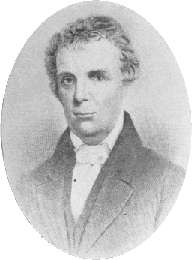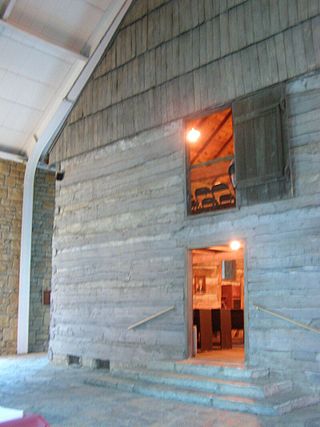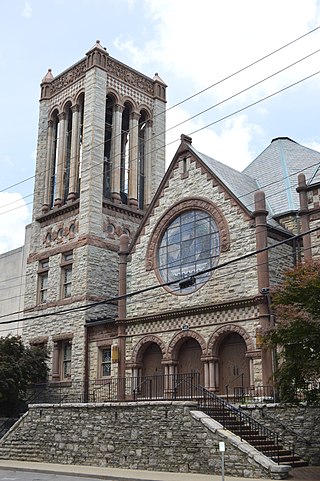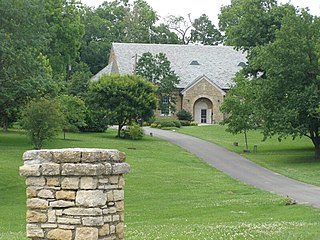
The Christian Church (Disciples of Christ) is a mainline Protestant Christian denomination in the United States and Canada. The denomination started with the Restoration Movement during the Second Great Awakening, first existing during the 19th century as a loose association of churches working towards Christian unity, then slowly forming quasi-denominational structures through missionary societies, regional associations, and an international convention. In 1968, the Disciples of Christ officially adopted a denominational structure at which time a group of churches left to remain nondenominational.

The Second Great Awakening was a Protestant religious revival during the early 19th century in the United States. The Second Great Awakening, which spread religion through revivals and emotional preaching, sparked a number of reform movements. Revivals were a key part of the movement and attracted hundreds of converts to new Protestant denominations. The Methodist Church used circuit riders to reach people in frontier locations.

Paris is a home rule-class city in Bourbon County, Kentucky the county seat. It lies 18 miles (29 km) northeast of Lexington on the Stoner Fork of the Licking River. It is part of the Lexington–Fayette Metropolitan Statistical Area. As of 2020, it had a population of 10,171.

The Restoration Movement is a Christian movement that began on the United States frontier during the Second Great Awakening (1790–1840) of the early 19th century. The pioneers of this movement were seeking to reform the church from within and sought "the unification of all Christians in a single body patterned after the church of the New Testament."

The camp meeting is a form of Protestant Christian religious service originating in England and Scotland as an evangelical event in association with the communion season. It was held for worship, preaching and communion on the American frontier during the Second Great Awakening of the early 19th century. Revivals and camp meetings continued to be held by various denominations, and in some areas of the mid-Atlantic, led to the development of seasonal cottages for meetings.

Barton Warren Stone was an American evangelist during the early 19th-century Second Great Awakening in the United States. First ordained a Presbyterian minister, he and four other ministers of the Washington Presbytery resigned after arguments about doctrine and enforcement of policy by the Kentucky Synod. This was in 1803, after Stone had helped lead the mammoth Cane Ridge Revival, a several-day communion season attended by nearly 20,000 persons.

The Red River Meeting House was the site of the first religious camp meeting in the United States. Held June 13–17, 1800, it marked the start of the Second Great Awakening, a major religious movement in the United States in the first part of the nineteenth century. The meeting was organized by the Presbyterian minister James McGready in Logan County, Kentucky, and several preachers took part.

The Cane Ridge Revival was a large camp meeting that was held in Cane Ridge, Kentucky, from August 6 to August 12 or 13, 1801. It has been described as the "[l]argest and most famous camp meeting of the Second Great Awakening." This camp meeting was arguably the pioneering event in the history of frontier camp meetings in America.
Bullittsburg Baptist Church is located at 2616 Bullittsburg Church Road, Petersburg, Boone County, Kentucky. This Baptist Church was organized in June, 1794, by Elders John Taylor (1752-1833), Joseph Redding, and William Cave. The church erected the first house of worship in 1797. This is the oldest church in the northern region of Kentucky.

As of the 2010 census, the United States Commonwealth of Kentucky had an estimated population of 4,339,367, which is an increase of 297,174, or 7.4%, since the year 2000. Approximately 4.4% of Kentucky's population was foreign-born as of 2010. The population density of the state is 107.4 people per square mile.
The Brush Run Church was one of the earliest congregations associated with the Restoration Movement that arose during the Second Great Awakening of the early 19th century. In 1811, a congregation of Christian reformers known as the Christian Association of Washington (Pennsylvania) reconstituted itself as a church and constructed a new building to replace the temporary log building where they began. Because it was built on the farm of William Gilchrist, near a stream called Brush Run, both the building and the congregation became known as Brush Run Church. It was the center of activity for Thomas and Alexander Campbell, father and son respectively, in their movement for Christian reform on the American frontier. The meeting house was later used as a blacksmith shop, then as a post office and finally it was moved to Bethany, Virginia.
Heritage Village Museum is a recreated 1800s community in Southwestern Ohio, in the United States. The village contains 13 historic buildings from around the Cincinnati area; they were moved here to save them from destruction. The village is located within Sharon Woods Park in Sharonville, Ohio.

David Purviance, November 14, 1766 – August 19, 1847, was a member of the Kentucky legislature, a member of the Ohio legislature, and an important early leader in the Stone-Campbell Restoration Movement. He was also an early trustee (1819–1836) of Miami University in Oxford, Ohio, and often served as its president pro tempore.

The David Brown House is located 4 miles (6.4 km) north of Rising Sun, Indiana and approximately 3 miles (4.8 km) south of Laughery Creek. The log home was placed on the Indiana Register of Historic Sites and Structures on October 25, 1978.

The Central Christian Church in Lexington, Kentucky, is a historic church at 205 E. Short Street, and an active congregation of the Christian Church. The church was founded by Barton Stone and was the place where the Stone and Campbell movements united to form in 1832 as part of the Restoration Movement. The church was previously known as Hill Street Christian Church and Main Street Christian Church.
The Christians (Stone Movement) were a group arising during the Second Great Awakening of the early 19th century. The most prominent leader was Barton W. Stone. The group was committed to restoring primitive Christianity. It merged with the Disciples of Christ (Campbell Movement) in 1832 to form what is now described as the American Restoration Movement (also known as the Stone-Campbell Restoration Movement.)

The Tinkling Spring Presbyterian Church, is a Presbyterian church founded in 1740, and is the oldest Presbyterian congregation in the Valley of Virginia. Its historic building is listed on the National Register of Historic Places (NRHP).
The Revival of 1800, also known as the Red River Revival, was a series of evangelical Christian meetings which began in Logan County, Kentucky. These ignited the subsequent events and influenced several of the leaders of the Second Great Awakening. The events represented a transition from British traditions to innovations arising from the unique needs and culture of Americans in the new century, especially on the frontier. The startling manifestations of revival fervor that first occurred in June 1800 at the Red River Meeting House, a small Presbyterian congregation led by James McGready, began as a Scottish sacrament service, but led to the important innovation of serial religious services later known as camp meetings.




















